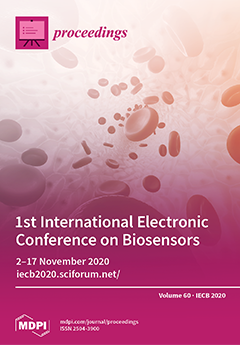Need Help?
Proceedings, 2020, IECB 2020
The 1st International Electronic Conference on Biosensors
online | 2–17 November 2020
Volume Editors:
Giovanna Marrazza, 1 University of Florence, Italy; 2 Istituto Nazionale Biostrutture e Biosistemi (INBB), Italy
Sara Tombelli, CNR-IFAC, Italy
- Issues are regarded as officially published after their release is announced to the table of contents alert mailing list.
- You may sign up for e-mail alerts to receive table of contents of newly released issues.
- PDF is the official format for papers published in both, html and pdf forms. To view the papers in pdf format, click on the "PDF Full-text" link, and use the free Adobe Reader to open them.
Cover Story (view full-size image):
This volume gathers papers presented at the 1st International Electronic Conference on Biosensors (IECB), a conference with the main goal of facilitating the engagement of worldwide well-known
[...] Read more.
This volume gathers papers presented at the 1st International Electronic Conference on Biosensors (IECB), a conference with the main goal of facilitating the engagement of worldwide well-known experts who are currently working in biosensor technologies and providing an online forum for the presentation and discussion of new results. Through online live sessions, discussions and other activities, the conference covered the following topics: technologies for innovative biosensors; bioengineered and biomimetic receptors; microfluidics for biosensing; biosensors for emergency situations; nanotechnologies and nanomaterials for biosensors; intra- and extra-cellular biosensing; advanced applications in clinical, environmental, food safety, and cultural heritage fields; biosensors for pathogens.
Previous Issue
Next Issue
Issue View Metrics
Multiple requests from the same IP address are counted as one view.



